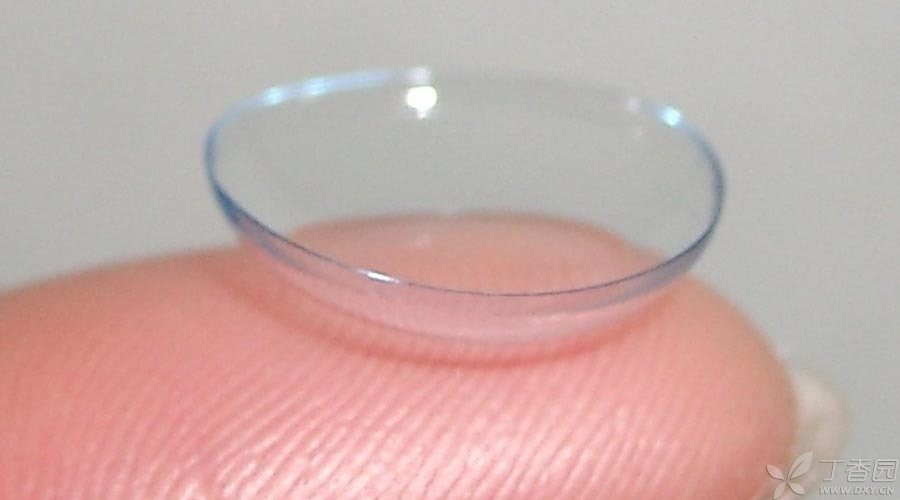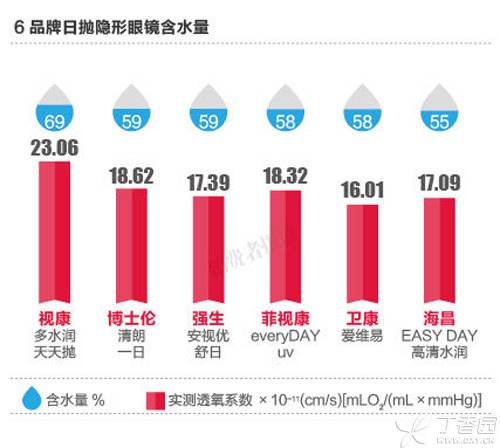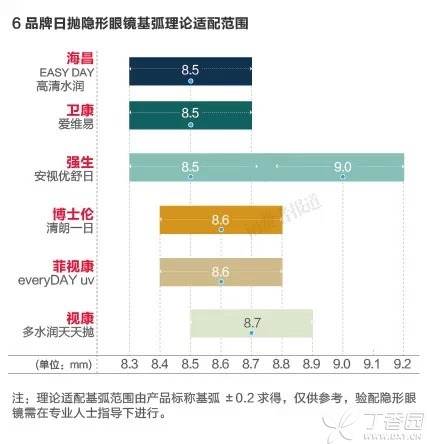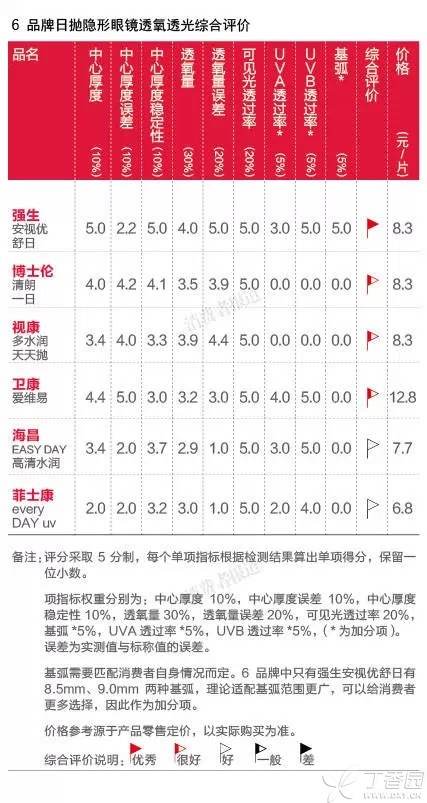
After meeting the basic requirement of correcting vision, major contact lens manufacturers have begun to work hard on wearing experience, and the application of new materials and technologies has really made contact lenses more comfortable.
The concept of “water” appears in almost all contact lens advertisements. Many contact lens products have water patterns or the word “water” printed on their packaging, which all convey the benefits of “water”-keeping the eyes dry when worn.
In sharp contrast to moisture, the most basic indexes such as base arc, diameter and water content are not specifically introduced in the product, and these indexes really affect the wearing comfort.
Is what’s information hidden behind the marketing gimmicks? Facing the cold product parameters, how should consumers choose? Which product has higher comfort and better light transmission?
In November 2014, [Consumer Reports] submitted 6 brands of daily contact lenses such as Johnson & Johnson, Boshlen, Shikang, Haichang, Weikang and Fishikang to a third-party authoritative testing organization for inspection, testing center thickness, oxygen permeability, light transmission and other indicators.
Based on these indexes, Johnson & Johnson, Anshi and Youshuri perform better in terms of oxygen permeability and light permeability, while Haichang EASY DAY High Water Moisture and FisheverDAY UV perform slightly poorly due to poor center thickness error and oxygen permeability.
Although contact lenses belong to three types of medical devices, due to various reasons, they are more sold as fast-moving products, which are within easy reach and can be bought and used immediately. However, the low-key and well-meaning tips of merchants-[please use them under the guidance of doctors or professionals] seem to have become empty words.
High water content is a double-edged sword.
Many consumers will think that the high water content in contact lenses will bring more moist effect, but this is not necessarily the case, and the high water content is not suitable for everyone.
There are two kinds of materials for soft contact lenses, silicon hydrogel and hydrogel. The 6 brands of daily contact lenses submitted for inspection in this [Consumer Report] are all hydrogel materials.
Compared with silicon hydrogel contact lenses with certain hardness, hydrogel contact lenses are more comfortable to wear because of their high water content and soft texture.
If only literally understood, the water content of contact lenses and the degree of moisture seem to be the same thing. Consumers who do not know the truth can easily enter a misconception-the higher the water content, the higher the degree of moisture, and then assert that contact lenses with 70% water content are more moist than contacts with 50% water content.
However, the fact is that with the increase of water content, it may also bring adverse effects such as dry eyes.
Li Jianhua, director of optometry and myopia prevention and control department of Guangzhou Aier Ophthalmology Hospital, explained to this reporter, Lenses with high water content are more likely to evaporate water than lenses with low water content. After evaporation is reduced, contact lenses will absorb water from the eye surface. The result of wearing for a long time is to make people feel dry and itchy eyes. [It is said that water content is not as good as water absorption,] he said.
It is worth noting that the water in the contact lens can conduct oxygen well. Therefore, the higher the water content, the better the oxygen permeability. This newspaper’s test results also confirm this point. Shikang’s daily contact lens has the highest water content, but actually the oxygen permeability coefficient measured is also the highest in 6 brands. (Figure below)

In short, the higher the water content, the softer the lens, the weaker the foreign body sensation, and the better the oxygen permeability, but at the same time, it is also more likely to cause discomfort such as dry eyes. So, how should consumers weigh the water content?
[It depends on the actual situation of consumers’ eyes], Li Jianhua said. [For consumers with poor tear secretion, in order to avoid discomfort such as dry eyes, it is recommended to choose products with lower water content.]
It is understood that foreign countries already have ultra-high water content bionics lenses, at the same time can avoid water evaporation. Now in China, enterprises are adding hyaluronic acid and other water-retaining components to high water-containing lenses to alleviate water evaporation to achieve the purpose of moistening. However, how effective it is still to be tested by consumers.
Is one base arc enough?
On the other hand, the base arc is also an important indicator of whether consumers are comfortable when wearing, but there is a lack of relevant introduction in most contact lens product packaging.
The corneal surface has a certain radian, namely the base arc. In order to achieve the best visual correction effect and comfort, the radian of the contact lens should be adapted to the cornea. The flatter the cornea, the larger the base arc of the adapted contact lens, and vice versa.
If the base arc of the contact lens is too small, it will cause certain compression on the cornea and hinder the exchange of tears. On the contrary, if the base arc is too large, it may cause slides, lenses and even slides out of the orbit, affecting the visual quality.
Dr. Mei Ying, director of dawn optometry technology, told [Consumer Reports] reporters that consumers can only choose suitable contact lenses after getting a trial lens base arc suitable for cornea through regular matching examination. Therefore, if you want to find a pair of contact lenses suitable for yourself, consumers should first understand the situation of their eyes.
Among the 6 brands of products in this comparative test, there are four basic arcs of 8.5 mm, 8.6 mm, 8.7 mm and 9.0 mm. If the basic arcs required by consumers are not these four values, can they make a suitable choice?

[Generally speaking, the difference between 0.2 mm and 0.3 mm is acceptable.] Yang Xiao, director of the Contact Lens Center of Zhongshan Ophthalmology Center, told this newspaper that this allowable range has also been approved by other experts.
Because hydrogel contact lenses are soft and easy to cling to the corneal surface, even a single base arc can adapt to a wide range of wearers. The design range of soft lens base arc is usually between 8.2 mm and 9.0 mm. At present, many manufacturers produce lenses with only one or two base arcs, which can meet the needs of most consumers.
[Generally speaking, the choice of base arc should be loose rather than tight.] Yang Xiao said.
However, it should be noted that even for products with the same base arc, the peripheral design of different lenses may not be the same, and the feeling when wearing will be different. Therefore, it still needs to be decided under the guidance of professional fitting personnel and according to the final results of fitting evaluation.
Yang Xiao introduced that the formal contact lens fitting includes at least detailed inquiry, slit lamp examination, eye parameter measurement, trial wear evaluation, wearer education and other steps, and should be reviewed one month, three months and six months after the fitting.
However, the current situation is that formal testing is often ignored. Consumers buy contact lenses directly or online. The process is convenient and the price is cheap. However, behind the convenience and cheap, there are no small risks.
According to several ophthalmologists interviewed by this newspaper, corneal complications related to contact lenses are mostly due to irregular matching and unhealthy wearing habits.
[Consumer Reports] Based on the relevant evaluation data of 6 brands of daily contact lenses submitted for inspection, The comprehensive evaluation of the oxygen permeability that affects the wearing comfort and the light permeability of eye protection was carried out. Among them, Johnson Anshi Youshu Ri’s comprehensive index performed well, while Haichang EASY DAY High Water Run and Fiscone EveryDAY UV scored slightly poorer due to the center thickness error and poor oxygen permeability.

This ranking is provided to consumers as a reference. As contact lenses are quite different from ordinary foods and daily necessities, and also have certain requirements on the condition of users’ corneas, this newspaper suggests that consumers must decide specific products and parameters under the guidance of ophthalmologists or professional matching personnel.
Author: Ji Hao
The article was reprinted by Clove Garden authorized by Consumer Reports.
